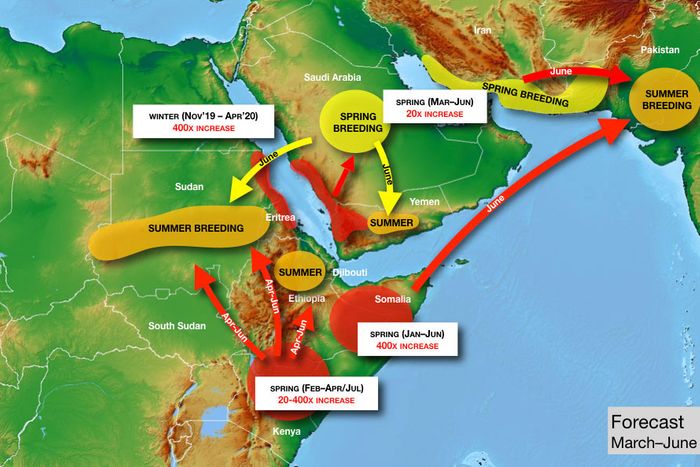nivek
As Above So Below
As if the World didn't have enough to deal with right now...
...
https://news.yahoo.com/massive-locust-swarm-africa-middle-144211394.html
So There’s a Locust Plague Too?
As the coronavirus continues to spread on six continents, a desert locust outbreak has inundated East Africa with hundreds of billions of bugs, causing food shortages in Kenya, Somalia, and Ethiopia. “It was like an umbrella had covered the sky,” Joseph Katone Leparole, a 68-year-old living in central Kenya, told the New York Times.
In our age of overlapping crises, it shouldn’t be a surprise that climate change can be identified as a factor in the upsurge, the technical term used for such a natural disaster that is just below plague. It began in 2018, when a pair of cyclones came in from the Indian Ocean and hit the “empty quarter” of the Arabian peninsula — the vast desert region near the borders of Saudi Arabia, Yemen, and Oman. In a speech before the African Union in February, U.N. general secretary António Guterres explained the unfortunate cycle: “Warmer seas mean more cyclones, generating the perfect breeding ground for locusts.”
“When you have rains associated with cyclones, they’re much stronger than normal,” said Keith Cressman, the senior locust-forecasting officer at the United Nations’ Food and Agriculture Organization. “When those rains fall in desert areas with sandy soil, that will flood the soil. Once those floods recede, the soil retains so much moisture that it allows desert locust females to lay their eggs probably for a period of around six months.”
From these ideal conditions, the bugs moved south into Yemen (already in a food crisis, Yemenis turned to them as a protein source) and into the Horn of Africa. The spread was rapid: A single locust can travel up to 90 miles in a day and eat its own weight in plant matter, of which there was a bounty, thanks to the excessive rains. They also turned north, across the Persian Gulf into Iran, and into India and Pakistan last summer. National emergencies have been declared in Pakistan, Jordan, and Somalia to help mobilize a response: The only effective control operation once a swarm is in motion is to spray pesticide directly on the bugs from the air.
To help understand the crisis, Intelligencer spoke with the FAO’s Cressman about some of the bugs’ idiosyncrasies and what to expect in the coming months.
(more on the link)

...
https://news.yahoo.com/massive-locust-swarm-africa-middle-144211394.html
So There’s a Locust Plague Too?
As the coronavirus continues to spread on six continents, a desert locust outbreak has inundated East Africa with hundreds of billions of bugs, causing food shortages in Kenya, Somalia, and Ethiopia. “It was like an umbrella had covered the sky,” Joseph Katone Leparole, a 68-year-old living in central Kenya, told the New York Times.
In our age of overlapping crises, it shouldn’t be a surprise that climate change can be identified as a factor in the upsurge, the technical term used for such a natural disaster that is just below plague. It began in 2018, when a pair of cyclones came in from the Indian Ocean and hit the “empty quarter” of the Arabian peninsula — the vast desert region near the borders of Saudi Arabia, Yemen, and Oman. In a speech before the African Union in February, U.N. general secretary António Guterres explained the unfortunate cycle: “Warmer seas mean more cyclones, generating the perfect breeding ground for locusts.”
“When you have rains associated with cyclones, they’re much stronger than normal,” said Keith Cressman, the senior locust-forecasting officer at the United Nations’ Food and Agriculture Organization. “When those rains fall in desert areas with sandy soil, that will flood the soil. Once those floods recede, the soil retains so much moisture that it allows desert locust females to lay their eggs probably for a period of around six months.”
From these ideal conditions, the bugs moved south into Yemen (already in a food crisis, Yemenis turned to them as a protein source) and into the Horn of Africa. The spread was rapid: A single locust can travel up to 90 miles in a day and eat its own weight in plant matter, of which there was a bounty, thanks to the excessive rains. They also turned north, across the Persian Gulf into Iran, and into India and Pakistan last summer. National emergencies have been declared in Pakistan, Jordan, and Somalia to help mobilize a response: The only effective control operation once a swarm is in motion is to spray pesticide directly on the bugs from the air.
To help understand the crisis, Intelligencer spoke with the FAO’s Cressman about some of the bugs’ idiosyncrasies and what to expect in the coming months.
(more on the link)

